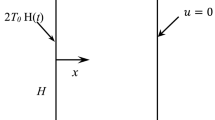Abstract
This work applies the method of multi-region boundary element to analyze the thermal stress intensity factor (TSIF) of the bi-material interface cracks subjected to linear and quadratic temperature distribution. An attempt is also made to resolve the problem containing body force which is caused by the inhomogeneous thermal loading by, initially, separating the solution of the inhomogeneous problem of each material into homogeneous and particular solutions, as proposed by Sung. The particular solution can be obtained by expanding the body force into Fourier series and, then, solving each term of the Fourier series. Next, inserting the obtained particular solutions into the boundary conditions of the original problem allows us to reduce the inhomogeneous problem to a homogeneous one. Moreover, the program of thermal multi-region BEM (TMBEM), which neither requires a domain integral nor changes the kernel functions, is established by imposing the continuity conditions on the interfaces. Finally, the applications of TMBEM are illustrated by evaluating the TSIFs of the interface cracks of bi-material subjected to linear and quadratic temperature distributions.
Similar content being viewed by others
References
Blandford, G.E. (1981). Two-dimensional stress intensity factor computations using the boundary element method. International Journal for Numerical Methods in Engineering 17, 387–404.
Becker, A.A. (1992). The Boundary Element Method in Engineering, McGraw-Hill, New York.
Chen, W.H. and Ting, K. (1985). Finite element analysis of mixed-mode thermoelastic fracture problems. Nuclear Engineering and Design 90, 55–65.
Danson, D.J. (1981). A Boundary Element Formulation of Problems in Linear Isotropic Elasticity with Body Forces in Boundary Element Methods, Springer-Verlag, Berlin.
Dundurs, J. (1967). Effect of elastic constants on stress in a composite under plane deformation. Journal of Composite Material 1, 310.
Erdogan, F. (1959). Stress distribution in bonded dissimilar materials with crack. Journal of Applied Mechanics 32, 403–410.
Hellen, T.K. (1979). On the solution of the center cracked plate with a quadratic thermal gradient. Engineering Fracture Mechanics 12, 469–478.
Henry, D.P. and Banerjee, P.K. (1988). A new boundary element formulation for two-and three-dimensional thermoelasticity using particular integrals. International Journal of Numerical Methods in Engineering 26, 2061–2077.
Hutchinson, J.W., Mear, M. and Rice, J.R. (1987). Crack paralleling an interface between dissimilar materials. Journal of Applied Mechanics 54, 828–832.
Kane, J.H. (1994). Boundary Element Analysis in Engineering Continuum Mechanics, Prentice Hall, New Jersey.
Meyer, M. and Schmauder, S. (1992). Thermal stress intensity factors of interface crack in bimaterials. International Journal of Fracture 57, 381–388.
Prasad, N.N.V., Allabadi, M.H., and Rooke D.P. (1994). The dual boundary element method for thermoelastic crack problems. International Journal of Fracture 66, 255–272.
Raveendra, S.T. and Banerjee, P.K. (1992). Boundary element analysis of cracks in thermally stressed planar structures. International Journal of Solids and Structures 29, 2301–2317.
Rizzo, D.J. and Shippy F.J. (1977). An advanced boundary integral equation method for three dimensional thermoelasticity. International Journal of Numerical Methods in Engineering 11, 1753–1768.
Sih, G.C. and Rice, J.R. (1964). The bending of plates of dissimilar materials with drack. Journal of Applied Mechanics 31, Trans. ASTM 86, 477–482.
Sladek, V. and Sladek, J. (1983), Boundary integral equation method in thermoelasticity Part I: General analysis. Applied Mathematic Modelling 7, 241–253.
Sladek, V. and Sladek, J. (1984), Boundary integral equation method in thermoelasticity Part III: Uncoupled thermoelasticity, Applied Mathematic Modelling 8, 413–418.
Suga, T., Elssner, G., and Schmauder, S. (1988). Composite parameters and mechanical compatibility of material joints. Journal Composite Material 22, 917–934.
Sumi, N. (1980). Thermal stress singularities at tips of a griffith crack in a finite rectangular plate. Nuclear Engineering and Design 60, 389–394.
Sung, J.-C., Tarn, J.-Q., Shiau, R.-J., and Twu, T.-M. (1991). BEM analysis of cracked bodies with body force. Journal of the Chinese Institute of Civil and Hydraulic Engineering 2, 175–183.
Tang, W. (1988). Transformation Domain into Boundary Integrals in BEM, Springer-Verlag, New York.
Tan, C.L. and Gao, Y.L. (1990). Treatment of bimaterial interface crack problem using the boundary element method. Engineering Fracture Mechanics 36, 919–932.
Wilson, W.K. and Yu, I.-W. (1979). The use of the J-integral in thermal stress crack problems. International Journal of Fracture 15, 377–387.
Author information
Authors and Affiliations
Rights and permissions
About this article
Cite this article
Chung, YL., Chang, CY. & Chien, CC. Boundary element analysis of interface cracks subjected to non-uniform thermal loading. International Journal of Fracture 110, 137–154 (2001). https://doi.org/10.1023/A:1010815406435
Issue Date:
DOI: https://doi.org/10.1023/A:1010815406435




